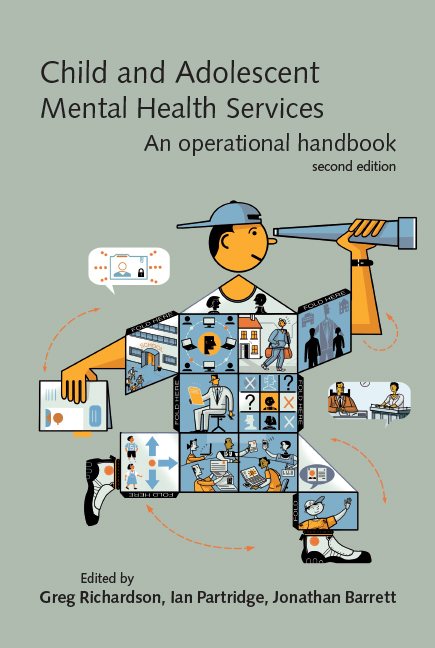Book contents
- Frontmatter
- Contents
- Tables, boxes and figures
- Contributors
- Abbreviations
- Preface
- 1 Introduction
- 2 CAMHS in context
- 3 CAMHS and the law
- 4 Structure, organisation and management of CAMHS
- 5 Evidence-based practice
- 6 Clinical governance
- 7 Education, supervision and workforce development
- 8 Multidisciplinary working
- 9 User and carer participation and advocacy
- 10 A comprehensive CAMHS
- 11 Referral management
- 12 Demand and capacity management
- 13 Strategies for working with Tier 1
- 14 Structuring and managing treatment options
- 15 CAMHS in the emergency department
- 16 Paediatric liaison
- 17 Self-harm
- 18 Learning disability services
- 19 Services for autism-spectrum disorders
- 20 Attentional problems services
- 21 Eating disorder teams
- 22 Bereavement services
- 23 CAMHS for refugees and recent immigrants
- 24 CAMHS and looked-after children
- 25 Drug and alcohol teams
- 26 Parenting risk assessment service
- 27 Court work
- 28 Tier 4 options
- 29 In-patient psychiatric care
- 30 Forensic services
- 31 Neuropsychiatry and neuropsychology services
- 32 Mental health provision for deaf children: study of a low-incidence service provision
- 33 Chief Executives – what do they want and how do they get it?
- Index
14 - Structuring and managing treatment options
- Frontmatter
- Contents
- Tables, boxes and figures
- Contributors
- Abbreviations
- Preface
- 1 Introduction
- 2 CAMHS in context
- 3 CAMHS and the law
- 4 Structure, organisation and management of CAMHS
- 5 Evidence-based practice
- 6 Clinical governance
- 7 Education, supervision and workforce development
- 8 Multidisciplinary working
- 9 User and carer participation and advocacy
- 10 A comprehensive CAMHS
- 11 Referral management
- 12 Demand and capacity management
- 13 Strategies for working with Tier 1
- 14 Structuring and managing treatment options
- 15 CAMHS in the emergency department
- 16 Paediatric liaison
- 17 Self-harm
- 18 Learning disability services
- 19 Services for autism-spectrum disorders
- 20 Attentional problems services
- 21 Eating disorder teams
- 22 Bereavement services
- 23 CAMHS for refugees and recent immigrants
- 24 CAMHS and looked-after children
- 25 Drug and alcohol teams
- 26 Parenting risk assessment service
- 27 Court work
- 28 Tier 4 options
- 29 In-patient psychiatric care
- 30 Forensic services
- 31 Neuropsychiatry and neuropsychology services
- 32 Mental health provision for deaf children: study of a low-incidence service provision
- 33 Chief Executives – what do they want and how do they get it?
- Index
Summary
‘Life is short, the craft long to learn, opportunity fleeting, experiment deceptive and judgement difficult. Not only must the physician be ready to do his duty but the patient, the attendants, and external circumstances must all conduce to a cure.’
HippocratesIntroduction
The routine problems presenting to a CAMHS are likely to be addressed by those working at Tier 2 by an individual specialist mental health professional working with the problem. The demands of this everyday CAMHS work require all the specialist skills available in the service. No professional, unless at a very inexperienced stage, should not be available for Tier 2 work. To some extent the expenditure of energy on the development of the more high-profile ‘specialist’ Tier 3 teams is secondary and needs to be carefully managed to maintain availability of Tier 2 specialist provision. Treatments such as CBT are often offered by Tier 3 teams, although service members with relevant skills will do this as part of their Tier 2 work. The system needs to be coordinated and managed so that there is equity of access for required services at the most effective tier.
Requisites of Tier 2
‘Critical mass’ of staff
Meeting the needs of the community and providing a comprehensive range of services requires a critical mass of CAMHS staff with a multidisciplinary skill mix and a clear recognition of professional function.
Assessment
Assessment represents the first stage of any therapeutic relationship and professionals working at Tier 2 need a clear model of assessment.
Continuum of care
The Tier 2 professional, who may link up with Tier 1 workers, will also be in a position to access and make use of Tier 3 and Tier 4 provision where required. This highlights the importance of communication both within CAMHS and with other agencies, as well as underpinning the principle that all disciplines should be involved in this area of service provision.
Training and supervision
Staff of all disciplines require access to affordable and relevant training. Training budgets are limited and unequal in their distribution. It may be that units develop alternative funding strategies to support less well-resourced disciplines. In-house training initiatives and multi-agency and multidisciplinary training programmes are effective and keep costs down. Professional supervision is a prerequisite for effective professional functioning.
- Type
- Chapter
- Information
- Child and Adolescent Mental Health ServicesAn Operational Handbook, pp. 127 - 137Publisher: Royal College of PsychiatristsFirst published in: 2017

